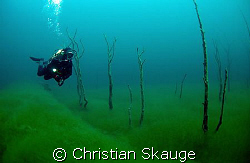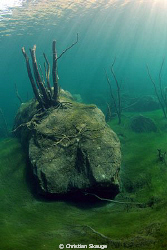How Hot is this Dive Site? click a star to rate it
Excellent divesite. The lake was created after a landslide blocked off the river Lygna in may 1908. In the lake you'll find farm houses, stone fences, a road, bridge and two gates. Also, there is a wierd and wonderful old forest - the troll forest.
Facts about Lygnstøylsvatnet It is in Norway
It is in Norway- The typical depth is 0-10 Metres 0-30 Feet.
- The typical visibility is 10-30 Metres 30-100 Feet.
| Photo facilities |
 |

by
Christian SkaugeUnderwater forest in lake Lygnstøylsvatnet, Norway.

by
Christian SkaugeLake Lygnstøylsvatnet, Norway. I 1908, a rockslide closed off the valley and it was flooded by the river. Some of the rocks are huge! This one must be older than the landslide though; it has trees growing on it ;-)